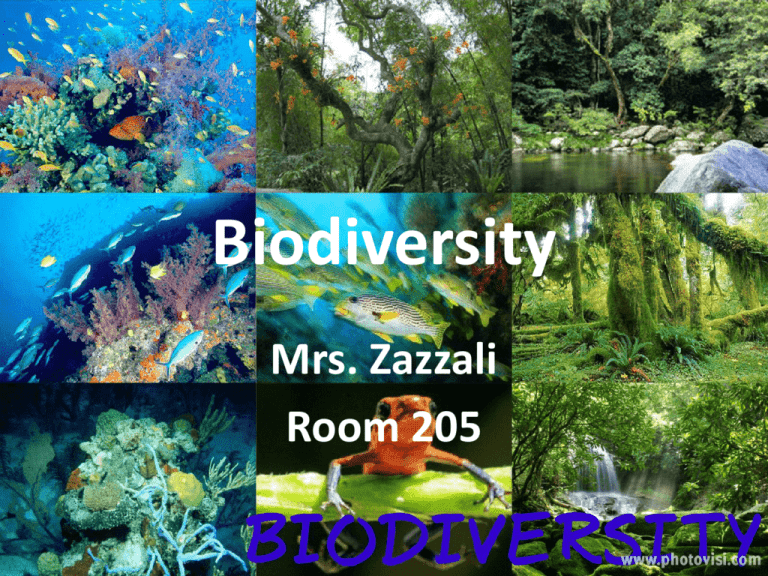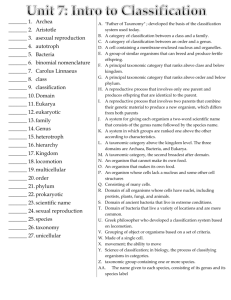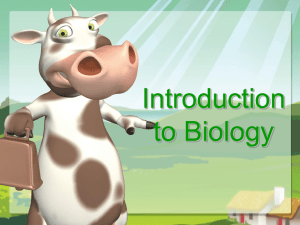Biodiversity Power Point Notes
advertisement

Biodiversity Mrs. Zazzali Room 205 What is an organism? • Any living thing that reproduces, grows, and adapts to its surroundings. Ex. Animals, Plants, Fungus, Protists, and Bacteria. What is a habitat? • Place where an organism lives depending on the organism ex. Monkey lives in the jungle • Where a species finds food • Natural home or shelter of an animal • Lives according to their needs • Adapts and responds to environment • And carries out life processes! What should I know about Taxonomy? • Taxonomy-the science of naming and classifying organisms (Thank you Linnaeus!) • All Taxonomic Categories go from the most broad category to the most specific and include: Taxonomic Category Mnemonic/trick to help you remember Kingdom King Phylum Phillip Class Came Order Over Family For Genus Great species Spaghetti The Scientific Name-Avoid the confusion! • Scientists refer to organisms with their Scientific Names to avoid confusion, a universal language. Remember all the confusion when I asked you to find the difference between a cougar, puma and mountain lion. You know now that they are really the same organism or animal known Scientifically as Puma concolar! Scientific Name cont. • Scientific Name is made of the Genus and species name. The first letter in the Genus is always spelled with an upper case letter and the species first letter is always lower case. The species is the most specific taxonomic category. • Examples: Genus species Homo sapien Canis familiaris Panthera leo Lesson 2 • Compound Light Microscope- Uses 2 lenses and light to make a specimen visible. *Look over your Microscope worksheet, know the parts* • Dry-Mount Slide- A microscope slide on which no water is used. (Our WOWBug slides) WOWBug and insect parts • Head- 1st body segment in insects (contain eyes, antennae and mandibles or jaw) • Thorax- 2nd body segment in insects, between the head and abdomen • Abdomen- A segment of the body of many animals, the third body segment in insects WOWBug Microscope Views of SpecimenBonus/Challenge words • Lateral- side view of a specimen • Ventral- abdominal view of a specimen • Dorsal- back view of a specimen Lesson 3 – Investigating Lumbriculus variegatus or the Blackworm • What did you learn? • Blackworms can regenerate both head and tail to break free from predators. • Lives in Ponds, Marshes and Lakes in N. America, and Europe. • Contain male and female sex organs. • Tail end used for sensing. • Can have 150—250 segments. • Under a microscope, you can monitor their pulse in bpm’s. Key Vocabulary • Anterior – toward the front, or head, of an animal body. • Posterior – toward the back end of an animal. • Regeneration – process by which organisms produce new body parts. Lesson 4 Vocabulary • Ecosystem- A community of organisms interacting with their abiotic environment. • Macroorganism- An organism that can be seen with out magnification, usually greater than 2 mm. • Microorganism- An organism that can not be seen with out magnification. • Habitat- A place where an organism naturally lives. Lesson 5 Vocabulary • Cell – The basic unit of life • Organelle – a well-defined structure found in a cell Animal Cell Key Parts to know • Cell Membrane – outer boundary that protects and allows materials to move in and out • Nucleus – The boss or CEO of the cell, the control center • Mitochondria – Mighty Mitochondria is the powerhouse or energy in the cell • Ribosomes – Make Protein • Endoplasmic Reticulum – The super highway or folded membrane where you find the ribosomes • Cytoplasm – Gel-like substance that houses the organelles Plant Cell Key differences • Cell Wall – extra rigid layer of protection made of cellulose • Chloroplast/chlorophyll- gives pigment to the plant and helps trap energy from the sun in Photosynthesis • Vacuole- much larger in plants, the storage center • Visit www.cellsalive.com for some practice! Lesson 6 – Protists and other Microorganisms • Kingdom Protista- one or many celled and Eukaryotic • Eukaryotic- Contain a nucleus and other membrane bound organelles, 4 Kingdoms of Life are Eukaryotic including: Protists, Fungi, Plants and Animals • Prokaryotic- Contains no nucleus or membrane bound organelles, 2 Kingdoms are Prokaryotic including: Eubacteria and Archaeabacteria Bacteria- Single celled and Prokaryotic • Good- Help your digestive and immune system, probiotics, give plants nutrients, help make medicine like antibiotics ***Mostly good only sometimes bad • Bad- cause disease or illness like Streptococcus or Salmonella • Two Kingdoms of Bacteria include Archaebacteria and Eubacteria Lesson 7 • • • • • • • • Vertebrate- Animal with a backbone Invertebrate- Animal with out a backbone Classes of Vertebrates: Mammalia-warm-blooded animals with hair/fur and can nurse their young Aves- warm-blooded with feathers/hollow bones Reptilia- cold-blooded w/scales & lay eggs on land Pisces- cold blooded, live in water, divided into jawless, cartilage and bony fish Amphibia- cold-blooded part of life in water and land, breathe through gills when young and lungs as adults, lay eggs in water Lesson 9 - Daphnia All about Daphnia- otherwise known as The Transparent Water Flea (pp 132-133) • Jointed Limbed Arthropod • Crustacean • Transparent Exoskeleton make them easy to study • Live in Freshwater • Important Food source for many organisms like Fish, important link in the food chain Lesson 10 – The Hydra • Hydra belong to the phylum Cnidaria, also called Cnidarians because they can sting • Freshwater organism • Tube like body with Tentacles • Tentacles draw up food • Asexual Reproduction known as budding, a new organism is produced from the body of another Lessons 11 & 12 • What do you know about the Fungi Kingdom? • Eukaryotic • Single or Multi-celled • Yeast are Single-celled • Reproduce Asexually and Sexually • Feed on other organisms • Decomposers Fungi Parts: Umbrella-shaped Cap (Reproductive structures), Mycelium, Hyphae that absorb and digest food, Sporangia (give color), Spores (Travel through the air) Vocabulary • Decomposers- an organism like bacteria or fungi, that breaks down dead plants and animals into simpler substances • Fermentation- when yeast feed on dough, they reproduce and excrete or produce Carbon dioxide and alcohol. • Respiration- The yeast then eat the alcohol and use Oxygen to turn its energy into fuel for growth and reproduction.









